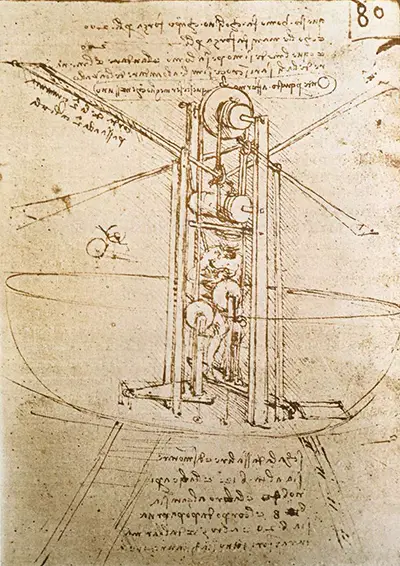This is because the period marked the paradigm shift that redefined the modernity of the human race.
Leonardo da Vinci, being one of the finest artists and inventors who ever traversed the surface of the earth, had a remarkable artistic flair for expressing every aspect of change that transpired or those that were imminent during this transitional period.
His meticulous observation skills, inexplicable imagination, and exquisite drawing prowess culminated into priceless pieces of antiques.
Having been intrigued by the then obscure phenomenon of flight, Leonardo da Vinci ventured into studying the mechanisms and dynamics of flight in birds.
Subsequently, he drew several plans for various flying machines that included light hang gliders, parachutes, and helicopters. One of the most spectacular works of Leonardo da Vinci is the ‘Flying machine’ whose design he drew in 1488.
This drawing was inspired by the flight mechanisms of animals with wings. The Flight Machine of 1488 is a drawing of a machine that encompasses and envisages replicating the flight of kites, bats, and various types of birds.
Leonardo da Vinci’s Flying Machine seemed to draw a lot of inspiration from the bat’s physique since both of its wings have significantly pointed towards ends; a clear replication of the bat’s wings. The device in the drawing has wings with a length close to 33 feet making it ideal for aviation.
The machine’s frame was to be made from pure strong pine that is totally enveloped in raw silk in order to give it a membrane which is not only strong enough to resist the wind currents but also light enough to enable the machine to take off. Leonardo da Vinci envisioned quite an unlikely position in which the pilot would have to be in order to make the machine to take off.
The pilot was expected to lie on a board while facing down at the machine’s centre. This position is strategic in the sense that it would enable the pilot to power the wings by pedalling a crank which is attached to a rod-and-pulley system.
Other than the pedal crank, the Flying Machine also had a hand crank which was meant to increase the machine’s energy output and transmission.
The bat-inspired wings would then flap spontaneously as the pilot spun the cranks thus making the machine to go air-borne. According to Leonardo da Vinci’s designs, the machine’s wings would be made in such a way that they would twist as they flap. The Flying Machine also had a headpiece that comes in handy for steering.
Despite Leonardo da Vinci’s drawing of 1488 being an epitome of creative imagination, it is rational and prudent to point out that in respect to the design and mechanisms of the Flying Machine, the pilot could not solely generate the requisite amount of energy to make the machine airborne.
Leonardo da Vinci’s 1488 drawing of the Flying Machine is a truly enchanting work of art that is greatly appreciated all over the world. The drawing is in the public domain in Venice, Italy, its country of origin and in many other areas including the Seattle Museum of Flight.


